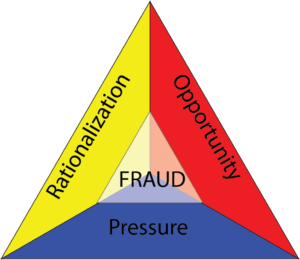Prevent Workplace Theft
Hiring the right talent for your organization is never an exact science. Hiring managers and teams must seek to make the best hiring decisions with the information they have available. Sometimes this inexact science results in a new hire that lacks certain skills or competence. In this scenario, a poor hiring decision can be overcome through employee training or coaching.
However, other times a bad hiring decision reveals itself in ways completely separate from employee performance. It may be the case that entirely capable employees are hurting an employer through more sinister means, specifically, through workplace theft.
The Association of Certified Fraud Examiners (ACFE), in it’s 2018 Report to the Nations, states that the median loss for U.S. companies due to fraud is $104,000. For small businesses, those with under 100 employees, the median loss nearly doubles to $200,000. It’s important to note that these figures are only for companies that reported fraud to the association at the time of the survey, which begs the question: how prevalent is workplace theft in the United States?
Unfortunately, that answer is not encouraging either. According to the U.S. Department of Commerce, it’s estimated that 75% of employees will steal from their employer at least once. And around one-third will become multiple offenders.
How does employee theft happen?
Workplace theft can take many forms. It’s not the case that employees are stealing $100,000 worth of paperclips. However, relatively minor instances of theft can set the stage (and build the workplace culture) for more costly crimes. Here’s an overview of what employee theft can include:
- Larceny: stealing cash or property from an employer.
- Embezzlement: when an employee in a position of legal authority and trust steals cash or property. For example, a cashier taking money from the register.
- Billing: setting up a fake payee account and paying that account (themselves) for fake goods or services.
- Payroll: writing payroll checks to employees that do not exist, or requesting compensation for more time than actually worked.
- Expense Reimbursement: submitting an expense report with line items that were not bought or were not business-related.
- Time Theft: using company time to conduct personal business.
- Information Theft: when employees use a company’s proprietary information to directly or indirectly benefit themselves.
Why does workplace theft happen?
The AFCE offers Cressey’s “fraud triangle” to concisely illustrate the psychology behind workplace theft.
Pressure
The path toward theft or fraud, begins with the employee experiencing or perceiving some type of pressure. This pressure is what makes the act of theft necessary or just in the mind of the employee. Some examples of this can include, a sudden financial set back or unexpected debt; or an employee’s belief that their work is not adequately compensated.
Opportunity
Once an employee feels the pressure to commit workplace theft, it’s only a matter of time that the employee will discover an opportunity to relieve that pressure. This opportunity often presents itself in work environments that lack controls for theft prevention, or in “flat” organizations that put a great deal of trust in each employee.
Rationalization
Finally, an employee will need to convince themselves that the act of theft is acceptable. There are many ways in which this can work. However, it’s often the case that an employee will fall into one of these categories:
- The employee believes they will simply borrow an item or resource.
- The immorality of stealing addresses the employer’s immorality of under-compensating or mistreating employees.
- The desperation of their situation necessitates theft (like Jean Valjean stealing bread).
- The theft is victimless. The employee doesn’t see the company as a person or collection of people, and so the theft is not harmful.
- The risk is worth the reward. The employee doesn’t believe they will be caught and/or doesn’t believe the punishment will be severe.
- It’s part of the company culture. An employee sees others committing theft and deems it acceptable.
How can employers prevent workplace theft?
With workplace theft so common, it’s nearly impossible to eliminate it completely. However, there are a number of measures a company can take that will minimize the possibility of employee theft.
Address theft in company policies.
Describe what constitutes theft by giving clear examples, and outline the punishment for theft. A zero-tolerance policy sends a strong message.
Be transparent in addressing workplace theft.
Ensure that all employees are aware of when theft occurs and the measures taken to address it. Ideally, those measures will be in alignment with the aforementioned company policies. This communicates to employees that the employer is serious about theft prevention.
Conduct more rigorous background checks.
Not all employees who have committed theft in the workplace are prosecuted. A simple check of police reports or criminal records will not insulate employers from hiring an employee with a history of theft. Employers must call on previous employers to help them gain a better picture of an employee’s character. This is especially important for any employee who will be handling money.
Informally audit on a consistent basis.
Ensure that there is more than one person responsible for reviewing financials, inventory, time, and attendance. This helps to hold a team accountable for the use of resources and can stop theft before it starts (lack of opportunity).
Develop process for reporting employee theft.
Empower employees to report suspicions or evidence of theft through an anonymous means. Often taking the form of a “tip hotline”, a theft reporting process is yet another deterrent for would-be thieves in the workplace.
Better hiring to prevent employee theft
Employee theft can exist unnoticed for years when it’s at a small scale. However, this existence has the potential to grow into more costly forms of fraud. The best way for employers to prevent workplace theft is to optimize the hiring process to screen out would-be thieves. This can include:
- Pre-screening assessments
- Interview questions that probe at an employee’s loyalty and integrity.
- Reference checks with the candidate’s previous employers to verify candidate’s reasons for leaving.
- Criminal background checks.
From there, employers must turn to developing a strong system of controls to educate and deter employees who may be at risk of committing theft. And when workplace theft does occur, an employer must be ready and willing to enforce company policies in a timely, effective manner.




